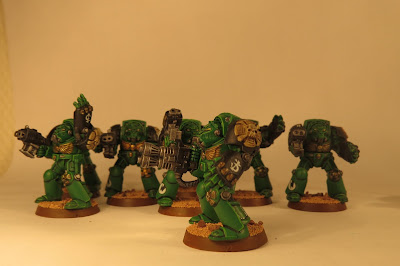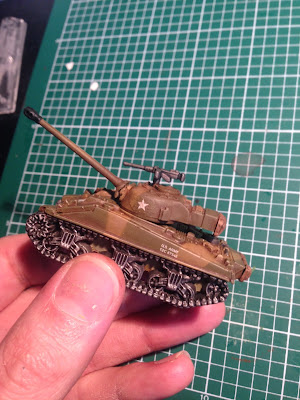Allez, je poste quelques articles avant mes vacances qui seront vendredi! J'ai quand même pas mal avancé cet été, et profité de soirées tranquilles pour manier l'aérographe. Je commence à avoir une belle petite force de Salamanders peinte, avec notamment une unité de dix Terminators. Bon alors, ne vous attendez pas aux poses dynamiques et aux gros socles, car il s'agit de Terminators ancienne version. En fait, il s'agissait de deux unités de 5, mais j'ai transformé un sergent en Terminator avec poing tronçonneur, en limant la bannière qui était sur le dos. En parlant de bannière, je n'ai pas encore posé celle que j'avais prévu de mettre sur le sergent, donc le produit n'est pas totalement fini. Néanmoins, les voici :
Here we are, I'm posting a few articles before going on holidays on Friday! I was able to get a few things done this summer and benefited from the quiet evenings to handle the airbrush. I'm starting to have a nice little painted force of Salamanders, including a unit of ten Terminators. Well, do not expect dynamic poses and big bases, because they are a much older version of Terminators. Actually, they were two units of 5, but I turned a sergeant into a Terminator with chainfist, by removing the banner that was on his back. Speaking of which, I have not yet glued the one I had planned to put on the sergeant, so the product is not completely finished. Nonetheless, here they are:
Pour l'épée énergétique du sergent, j'ai eu recours à l'aérographe et au tutoriel de Buypainted concernant la peinture des armes énergétiques que vous trouverez ici. J'ai dû m'y reprendre à deux fois car je n'avais pas laissé sécher la peinture de la première moitié assez longtemps. Finalement, j'ai réussi à ma deuxième tentative. La technique est finalement assez simple, il suffit de ne pas trembler : - masquer une partie de l'épée avec du scotch de peintre
- faire un dégradé à l'aérographe en suivant cet ordre : blanc, bleu clair, bleu foncé
- laisser sécher 24 heures
- répéter l'opération sur l'autre partie de l'épée, mais à l'envers : si vous avez commencé par le bleu en bas et la pointe blanche, faites la base blanche et la pointe bleue
For the Sergeant's power sword, I used my airbrush and the tutorial from Buypainted about painting energy weapons that you can find here. I had to do it twice because I had not let the paint on the first half of the sword dry long enough. Finally I succeeded on my second attempt. The technique is actually quite simple, just do not shake :
- Hide a part of the sword with masking tape
- Make a gradient with the airbrush in the following order: white, light blue, dark blue
- Let it dry for 24 hours
- Repeat on the other side of the sword, but the other was around: if you started down with the blue and white tip, make the base white and tip blue
Le poing tronçonneur est un bitz du kit actuel des Terminators
The chainfist is a bitz from the current Terminator kit
Et pour finir : le lance-flammes, toujours utile
And finally: the flamethrower, always helpful































